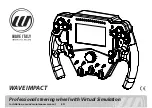
3
Except for low output battery-operated energizers, the energizer ground rods shall penetrate the ground
to a depth of at least 5 ft.
Care shall be taken to avoid any damage to cables or pipelines.
All energizers that are run inside buildings shall be effectively insulated from the grounded structural
parts of the building. This may be achieved by using insulated high voltage cable.
Energized leads that are run underground shall be run in a conduit of insulating material or else
insulated high voltage cable shall be used. Care shall be taken to avoid damage to the connecting leads
due to the effects of animal hooves or tractor wheels sinking into the ground.
Any leads connected to the fence or ground shall not be installed in the same conduit as the mains
supply wiring, communication cables or data cables.
Connecting leads and electric fence wires shall not cross above overhead power or communication
lines.
Crossings with overhead power lines shall be avoided wherever possible. If such a crossing cannot be
avoided, it shall be made underneath the power line and as nearly as possible at right angles to it.
If connecting leads and electric fence wires are installed near an overhead power line, the clearances
shall be not less than those shown in the table shown below.
Power Line Voltage
Air Distance
1,000 volts
10 ft.
> 1,000 33,000 volts
13 ft.
> 33,000 volts
26 ft.
If connecting leads and electric fence wires are installed near an overhead power line, their height above
the ground shall not exceed 6.5 ft.
This height applies to either side of the orthogonal projection of the outermost conductors of the power
line on the ground surface, for a distance of
– 6.5 ft .for power lines operating at a nominal voltage not exceeding 1,000 V;
– 50 ft. for power lines operating at a nominal voltage exceeding 1,000 V.
If connecting leads and electric fence wires are installed near a telecommunication line or a
telecommunication cable, their distance to the line or the cable shall be at least 50 ft.
Electric fences intended for deterring birds, household pet containment or training animals such as cows
need only be supplied from low output energizers to obtain satisfactory and safe performance.
In electric fences intended for deterring birds from roosting on buildings, no electric fence wire shall be
connected to the energizer earth electrode. The earth connection has to be done with a wire on
insulators. A warning plate, as described above, shall be fitted to every point where persons may gain
access to the conductors.
Where an electric animal fence crosses a public pathway, a non-electrified gate shall be incorporated in
the electric fence at that point or a crossing by means of stiles shall be provided. At any such crossing,
the adjacent electrified wires shall carry warning signs as described above.
Electric fence energizers have to be used in accordance with the position described in the instruction
manual.
If the installation of the energizer will be inside a building, care must be taken that the electric fence
energizer must not at all be installed in an inflammable room (stall, stable, barn). Also no easily
inflammable materials may be stored neither close to the fence, nor close to the connections of the
electric fence energizer.
In an attempt to limit lightning/surge damage a lightning diverter or arrestor must be installed on the
fence line at a point no less than 50ft. away from the energizer and its grounding system. This diverter
or arrestor needs to be at a point on the fence where any lightning/surge has to pass through it before
reaching the building and fence energizer. This must be done prior to attaching the leads on to the
fence energizer.
Do not connect to existing ground wires of the power supply system.

























